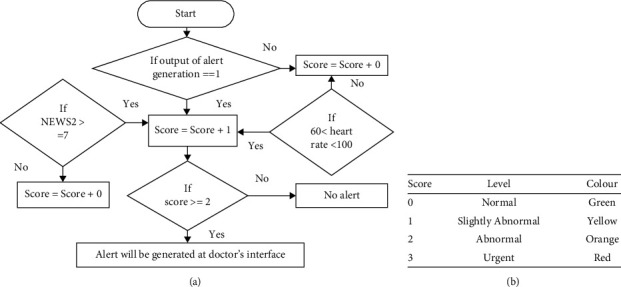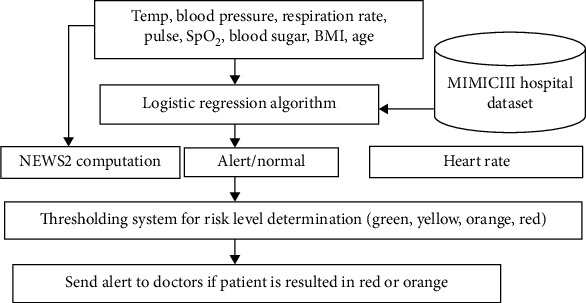Real-Time Remote Patient Monitoring and Alarming System for Noncommunicable Lifestyle Diseases.
IF 2.2
Q2 HEALTH CARE SCIENCES & SERVICES
International Journal of Telemedicine and Applications
Pub Date : 2023-11-20
eCollection Date: 2023-01-01
DOI:10.1155/2023/9965226
引用次数: 0
Abstract
Telemedicine and remote patient monitoring (RPM) systems have been gaining interest and received adaptation in healthcare sectors since the COVID-19 pandemic due to their efficiency and capability to deliver timely healthcare services while containing COVID-19 transmission. These systems were developed using the latest technology in wireless sensors, medical devices, cloud computing, mobile computing, telecommunications, and machine learning technologies. In this article, a real-time remote patient monitoring system is proposed with an accessible, compact, accurate, and low-cost design. The implemented system is designed to an end-to-end communication interface between medical practitioners and patients. The objective of this study is to provide remote healthcare services to patients who need ongoing care or those who have been discharged from the hospital without affecting their daily routines. The developed monitoring system was then evaluated on 1177 records from MIMIC-III clinical dataset (aged between 19 and 99 years). The performance analysis of the proposed system achieved 88.7% accuracy in generating alerts with logistic regression classification algorithm. This result reflects positively on the quality and robustness of the proposed study. Since the processing time of the proposed system is less than 2 minutes, it can be stated that the system has a high computational speed and is convenient to use in real-time monitoring. Furthermore, the proposed system will fulfil to cover the lower doctor-to-patient ratio by monitoring patients from remote locations and aged people who reside in their residences.



非传染性生活方式疾病患者实时远程监测与报警系统。
自2019冠状病毒病大流行以来,远程医疗和远程患者监测(RPM)系统因其在遏制COVID-19传播的同时提供及时医疗服务的效率和能力而受到卫生保健部门的关注并得到了调整。这些系统是使用无线传感器、医疗设备、云计算、移动计算、电信和机器学习技术的最新技术开发的。本文提出了一种可访问、紧凑、准确、低成本的实时远程患者监护系统。所实现的系统被设计为医生和患者之间的端到端通信接口。本研究的目的是为需要持续护理的患者或已经出院的患者提供远程医疗服务,而不影响他们的日常生活。然后对来自MIMIC-III临床数据集(年龄在19至99岁之间)的1177份记录评估开发的监测系统。性能分析表明,采用逻辑回归分类算法生成警报的准确率达到88.7%。这一结果积极地反映了所提出研究的质量和稳健性。由于该系统的处理时间小于2分钟,因此可以说该系统具有较高的计算速度,便于用于实时监控。此外,拟议的系统将通过监测来自偏远地区的患者和居住在其住所的老年人来满足较低的医患比例。
本文章由计算机程序翻译,如有差异,请以英文原文为准。
求助全文
约1分钟内获得全文
求助全文
来源期刊

International Journal of Telemedicine and Applications
HEALTH CARE SCIENCES & SERVICES-
CiteScore
6.90
自引率
2.30%
发文量
19
审稿时长
12 weeks
期刊介绍:
The overall aim of the International Journal of Telemedicine and Applications is to bring together science and applications of medical practice and medical care at a distance as well as their supporting technologies such as, computing, communications, and networking technologies with emphasis on telemedicine techniques and telemedicine applications. It is directed at practicing engineers, academic researchers, as well as doctors, nurses, etc. Telemedicine is an information technology that enables doctors to perform medical consultations, diagnoses, and treatments, as well as medical education, away from patients. For example, doctors can remotely examine patients via remote viewing monitors and sound devices, and/or sampling physiological data using telecommunication. Telemedicine technology is applied to areas of emergency healthcare, videoconsulting, telecardiology, telepathology, teledermatology, teleophthalmology, teleoncology, telepsychiatry, teledentistry, etc. International Journal of Telemedicine and Applications will highlight the continued growth and new challenges in telemedicine, applications, and their supporting technologies, for both application development and basic research. Papers should emphasize original results or case studies relating to the theory and/or applications of telemedicine. Tutorial papers, especially those emphasizing multidisciplinary views of telemedicine, are also welcome. International Journal of Telemedicine and Applications employs a paperless, electronic submission and evaluation system to promote a rapid turnaround in the peer-review process.
 求助内容:
求助内容: 应助结果提醒方式:
应助结果提醒方式:


